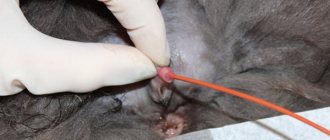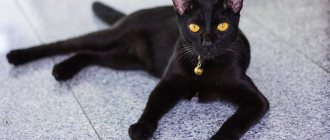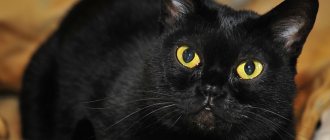The jungle cat or jungle cat has many other names: marsh lynx, house (from the Latin name Felis chaus), Nile cat, jungle cat. This diversity is explained by the fact that there are several subspecies of this representative of the cat family. It is the reed wild cats that have recently attracted the attention of exotic lovers. Their popularity stems from their relationship to the recently recognized hybrid Chausie breed, also known as the Hausie cat.
Jungle cats and cats in the wild
The jungle cat's extensive habitat extends from Western Asia and Asia Minor to Southwestern China. In Russia, it is found in the flat part of Dagestan and further on the coast of the Caspian Sea. Wild cats live in lowland forests along rivers and lakes. Rookeries are built on the ground, often in reed thickets. To make sleeping softer, they make themselves a bedding from wool and dry reed stalks.
There are nine subspecies of jungle cats. Some of them, such as the Caucasian jungle cat, are listed in the Red Book and are on the verge of extinction, while other species from Northern India or Pakistan are constantly expanding their population and living space.
Since ancient times, wild jungle cats have had a reputation as dangerous and unpredictable predators that even dogs are afraid of. People tried to avoid the Hausis. In addition, this animal caused serious problems for village residents in winter, when it attacked poultry in search of food. Hunters, in turn, caught jungle cats and used their skin.
In rare cases, people have found orphaned kittens, taken them home and raised them as pets.
Video: jungle cats in nature
Description of jungle cats
global $ads_google;
//data-ad-slot=”2475549904″ $ads_google = empty($ads_google) ? false : true; ?> if ($ads_google == false) {?> $ads_google = true; ?> } ?> Where today you can see ten subspecies of the predator in natural habitats, it is in Kashmir, the Caucasus (Caucasian reed cat), Indochina, South India, North India, Pakistan, the Nile River Valley in Egypt and on the island. Sri Lanka.
So, how can you recognize the “same” cat in a wild animal you meet?
Like the lynx, the jungle cat has small tufts at the tips of its ears. The color of the coat is very strongly influenced by the habitat: the main shades of the coat are brown, gray and brown with various combinations. Often a red stripe is visible along the spine. The ears, forehead and back of the head are also reddish, but the groin area and chin are whitish-yellowish. The gray tail has black rings and a tip. Newly born kittens will be completely tabby.
Companions from Central Asia and northern Africa are gray-yellow in color - nature made sure that the predator blends into the landscape. South Asian cats are tan. The first description of the Haus breed was made by the naturalist Johann Anton Güldenstedt in 1776: he saw a large, strong cat with rounded ears with tassels, like a lynx. The animal's muzzle is long, thin, and there are whitish markings near the eyes and dark spots near the nose. An interesting fact is that the tail of wild cats is much shorter than that of an ordinary domestic cat - a third of the length of the entire body and head.
Jungle cats live about 14 years.
Dimensions and weight of jungle cats
Even at a tender age, jungle kittens are quite large. They are born weighing about 136 g and grow continuously, adding 20-22 g per day.
Wild representatives of the species weigh from 12 to 16 kg, and domestic cats of the reed breed are much smaller: 6-12 kg, which is still larger than the size of the average adult cat. Females weigh less than males and appear less massive. The habitat also affects weight: cats living in western Israel weigh almost half as much as those living in India. Competition among individuals for the right to survive probably plays a role.
The length of these handsome cats reaches 100-120 cm, and their height at the withers is approximately 50-70 cm. Since the animal’s legs are long, strong and strong, if you put an ordinary pet side by side for comparison, the difference will be even more noticeable.
Appearance
Externally, jungle cats in many ways resemble ordinary domestic cats, but at the same time they have some lynx-like features: tufts on the ears, a wide, slightly square muzzle, high paws and wild coloring. The Hausie cat has impressive dimensions. Body length is 60-90 cm, height at the withers is about 40 cm. Average weight is from 8 to 14 kg. Males are much larger and more powerful than females.
The coat is short and the color varies slightly between species. The predominant color is reddish-brown, with lighter hair in some areas of the body. The tail is not long, it is approximately 1/3 of the length of the body. The physique is powerful, the muscles are well developed, the limbs are long and strong. The body is relatively short. The chest is square and wide.
The jungle cat is endowed with excellent hearing, and acute vision helps him to navigate well in the dark. The only thing nature deprived him of was his sense of smell. Of course, the animal distinguishes odors, but much worse than its fellows. What a Hausie cat looks like can be clearly seen in the photo.
How much does it cost and where to buy a Chausie kitten?
Do you want to have your own wild animal as a pet? Get ready to shell out some cash, because the average price for a kitten is 300,000 rubles.
Chausie kittens are sold in nurseries. You can try to search through breeders, but in Russia there are very few people breeding this breed. Animals from nurseries can even be imported from other countries. The largest number of Hausie cats are found in the United States. You can search for breeders through forums dedicated to this breed in Moscow and St. Petersburg.
The cost of a kitten depends on its generation. The price of chausie f1 is about 500,000 rubles and even more. F5 Houseies cost approximately 100,000 rubles - this is the minimum cost of a kitten of this breed. For some kittens you will even have to pay a million rubles.
Character and lifestyle
Jungle cats and male cats are predatory animals with complex temperaments. By nature they are loners, but everything changes with the onset of spring. In February-March, the mating season begins, which is no different from that of our domestic purrs, accompanied by screams, fights and the choice of brides. What follows are several months of family idyll. A cat and a female cat raise their offspring together, share shelter and provisions. Babies feed on mother's milk for up to 3 months. Already at 5 months they leave the parental nest, and the family breaks up.
Jungle cats are secretive and cautious, independent and independent with an active psyche. Behavior and lifestyle can be described in a few words: active, energetic, quiet and unpredictable. Adult animals can express their demands with a loud, deep meow, although it is worth noting that they are generally quite silent. The kittens only snort and hiss.
Born in captivity, babies are tamed very quickly and easily and have a calmer disposition, but wild blood periodically makes itself felt.
Reed cats see only one person as their owner; they will obey him, but in return they will require a lot of attention. By distinguishing the owner from others, they may show jealousy. Houses are very smart and willful, they value space and freedom. During the period of love exploration, they can be aggressive and dangerous, even if they are already accustomed to the person.
Character of jungle cats
The jungle cat is a 100% predator with an obstinate disposition.
They usually go out for active hunting closer to night, achieving amazing skill in this matter. Due to the fact that these animals have a very developed sense of smell and hearing, and are also excellent swimmers, a jungle cat is unlikely to be left without prey.
In the winter season, this predator also hunts in daylight, waiting in the thickets or setting up an ambush to catch prey. He can also catch birds, as he can jump quite high.
The secretive and very neat animal is usually alone and searches for a mate only during the breeding season.
Each adult male has his own territory - from fifty to two hundred meters around. Those domesticated cats that live with people outside the city are still dangerous for all domestic animals living nearby, even if we are talking about dogs.
If you decide to get yourself such a pet, you need to know that this is a very active and energetic cat with a wild character, so it is difficult to tame it and make it truly domestic.
He chooses only one owner and constantly requires attention. Animals with a deficiency of affection can become seriously offended by a person and even leave their home.
Adult cats make loud bass sounds, while tiny kittens make hissing and snorting noises. These animals are truly wise, they love freedom - the call of the ancient ancestors does not allow us to forget this.
When a jungle cat is looking for a mate, it can be very aggressive and dangerous to others.
Diet
The menu of jungle cats in the wild is very diverse, including: birds, reptiles, insects, fish and small mammals. They prefer to hunt at dusk or at night.
When going hunting, patient cats can wait in ambush for hours until the curious face of a small rodent appears from a hole. Birds are waylaid, hiding in the thickets, and then caught on takeoff. Reed cats often go fishing using cunning techniques. They carefully hit the surface with their paw, imitating the movement of insects, and then snatch out an unwary fish with their claws or dive headlong after it. If there are bird nests along the way, the house is sure to feast on eggs or young chicks.
What to feed a domestic jungle cat
It is recommended to feed an adult animal once a day. The daily menu should consist of approximately 200 g of meat. It could be lean beef, veal, a couple of live mice or one rat. Chickens and quails are also provided as live food. Fresh or live fish is offered once a week. An important component of the content are fasting days. Once a week for 24 hours, the predator goes on a starvation diet. Such measures are necessary to maintain the health and normal weight of the cat. Mandatory supplements include vitamins and fresh herbs. Kittens up to one year old eat twice a day, the diet is supplemented with dairy and fermented milk products, calcium supplements and other microelements.
Wild cats do not digest foods rich in fiber well, so you should not experiment with cereals and vegetables. Dry industrial foods should also be avoided.
Even holistic and super premium diets contain grains, and their protein composition cannot satisfy the needs of a wild cat and maintain the microflora of the digestive tract in the required balance.
Features of feeding
Small kittens are fed up to 6 times a day. The older the animal gets, the less frequent feeding becomes.
You should not introduce chicken as the first meat dish, as its poor quality may harm the kitten’s health. It is better to use a quality product.
In total, the diet should contain not only meat dishes, but also vegetable, fermented milk, and cereals.
Keeping jungle cats in captivity
Keeping wild cats is a troublesome and expensive task, but raising kittens is a responsible process that, in addition to patience, will require knowledge of the character of jungle cats, habits and the basics of zoopsychology.
Adult jungle cats that are caught in the wild do not take root and are not tamed at home. However, they are sold on the black market for captivity.
The optimal place to keep a jungle cat would be a country house. It is necessary to create such conditions so that the pet can run around to its fullest and find use for its instincts.
Living in an apartment or other confined space will not give you the opportunity to throw out all your energy. At first, this will manifest itself in damage to things, starting with furniture and tearing off the finish. In the future, the lack of sufficient physical activity will result in health and mental problems; animals can become nervous, uncontrollable and aggressive, or, on the contrary, apathetic. Bringing a jungle cat into your apartment is not a good idea. Another thing is their hybrids - cats of the Hausie (Chausie) breed, which have a softer character.
It is worth remembering that jungle cats pose a potential threat to other pets, including dogs. Even a domestic jungle cat can scratch or bite painfully.
A jungle cat lives in the apartment of an employee of the Yekaterinburg Zoo:
Taming and raising reed kittens
To prevent kittens from growing up aggressive, they must be picked up every day and communicated with them for a long time, played and caressed. If you miss just one day, they immediately start to go wild. Little kittens snort and hiss very terribly, and can put out their claws, but even this is not a reason to put them in a cage. Often cats grow up quite calm, allow themselves to be fed from their hands and caress their legs, but do not tolerate attempts to pet them well.
Origin of the swamp cat and domestication
This feline species was first described in scientific literature in the mid-18th century. The first cases of domestication of the jungle cat date back to Ancient Egypt. This animal reacted quite calmly to living next to a person. The images found suggest that the ancient race often used the Hausa to hunt hares.
In its natural habitats, this predator is very careful and silent, trying not to contact people for whom it does not pose a danger. But during rutting periods it is better not to meet with him. At this time the animal is quite aggressive.
This is a nocturnal animal that loves to hunt small rodents and birds, preferring especially overgrown areas for this. When living in an apartment or house, they retain their habits - they prefer to sleep during the day and show signs of activity at night.
Photo gallery of the jungle cat:
Where to buy a jungle cat: price and choice of kitten
Buying a jungle cat is not easy, but it is quite possible. Separate nurseries are engaged in breeding and selling babies. There are also companies that, among other exotic animals, sell wild cats.
Buying a jungle cat should be legal for at least two reasons. First, the animals must have documentary proof of origin and health, which may be required from the new owner. Secondly, buying kittens or adult cats that have been poached in the wild will most likely not turn out well. As already mentioned, the animal will remain wild and can only live in a closed enclosure.
Unfortunately, even in nurseries no one can guarantee the character with which a cat will grow up. Will he really become tame or will he remain wild despite all attempts to tame him?
Now let's move on to the question: how much does a Hausie cat cost? The price of a jungle cat kitten in Russia ranges from 100,000 -150,000 rubles. If cats are sold much cheaper, you should be wary of the offer. Some scammers pass off kittens of a similar color as reed kittens.
Health and feeding of the jungle cat
Typically, Houses have very good health, as well as a high love of games and mobility. But this will only happen if the owners have provided the pet with proper maintenance and proper care.
The main enemy of wild jungle cats is cold and frost. For this reason, the domestic jungle cat should be protected from hypothermia.
Another aspect that needs to be taken into account is the possibility of a short length of the intestinal tract genetically obtained from ancestors with pathology.
This affects, first of all, the possibility of complete and normal digestion of plant foods. The consequences of the presence of such a feature, if you ignore it, are gastric inflammation of the animal. Dry ready-made food is prohibited for feeding, even if it belongs to the premium and super-premium class. Manufacturers necessarily use cereals in production.
Houses do not require any special nutrition, but they will have to follow some specific rules to keep the pet healthy.
You need to be clearly aware of the fact that live food is very important for your pet, because it is this that will determine how normal and healthy the cat will be.
In addition to what has already been described above, the diet can include the following components:
- main – meat, offal; in nature, predators catch birds, rodents, and small mammals;
- boiled fish is allowed to be given once a week, more consumption is fraught with the occurrence of rickets;
- One-third of a Hausa menu can be plant-based. It happens that these cats themselves beg for a piece of cucumber, pumpkin or sweet juicy fruit. You shouldn’t deny them such pleasure.
A jungle cat living in a house is not able to waste as much energy as in the wild. That is why he may be at risk of obesity.
An animal at any age should receive a sufficient amount of vitamins and nutrients.
You should not experiment with cereals; the animal’s stomach will not be able to digest such food, and everything will end in failure. The choice of artificial ready-made food must also be approached carefully and very responsibly.
If you want to have a toy cat, this pet is definitely not for you. However, a person who loves elegant and wayward pets will definitely appreciate the jungle cat.
Chausie is a domesticated relative of the jungle cat
Often people refer to the jungle cat as the breed of domestic cats Chausie, which are hybrids of wild swamp cats and Abyssinian cats. American breeders began working on the breed in the late 60s. The new breed has adopted a fit, muscular body, color and large size from its wild counterparts, but at the same time has the character of a domestic cat. Today, Chausie cats are quite rare and one of the most expensive. The photo below shows that Hausie cats are very different from their wild relatives, but similar features in appearance can still be traced.
Chausie cat
The tendency to have various exotic animals at home is not always reasonable or justified. Often people follow an emotional impulse, but forget about the most important thing - raising and maintaining a wild creature is actually very difficult, expensive and troublesome. The bad thing is not only that animals end up dying for various reasons or are sent to zoos, but also that keeping them often leads to tragic accidents.
Hausie coat color and texture
Wool changes its structure significantly depending on the season. In summer it becomes tougher and looser. By winter, chausies become pubescent. The coat becomes thicker and softer. The undercoat becomes denser.
Read here Savannah - description of the breed, character and price of the cat. Expert advice on home care (85 photos)
The color completely matches the color of wild relatives. It can fluctuate a bit, but generally has sandy gray undertones.
Chausies may have a tendency to have a monochromatic coat, or exhibit spotting in the form of black spots and sometimes even stripes.
Personality of the pet
By its nature, the jungle cat is a pronounced predator . Even domesticated breeds prefer a nocturnal lifestyle; they are extremely active, tireless and inquisitive. If keeping a wild animal in captivity is a dubious pleasure, then domesticated varieties are distinguished by a calm disposition, they are friendly and extremely interesting to keep.
The so-called Chausie , which is a hybrid of an Abyssinian cat and a jungle cat, are very popular today. In appearance, Chausies are practically indistinguishable from their wild ancestor, but at the same time they are calm and friendly animals that do not cause any difficulties when kept in captivity.
Do not forget also about the need for castration and sterilization of animals . This will not only prolong the life of pets, but will also save the homeowner from any difficulties with an unpleasant odor from an animal that may be marking its territory.
When keeping a jungle cat at home, you should definitely buy a scratching post and a large tray . These animals need open, free space and also love to swim, so you should bathe your pet from time to time.
Care and maintenance
Any unusual pet, including the jungle cat, requires personal care.
Grooming
The house needs regular brushing only during shedding, which may not coincide with the change of seasons. In winter, compaction of the undercoat may not occur, since the premises are usually well heated. On the contrary, summer risks being cold, and then the fur will become thicker. You should use a comb on a daily basis if your pet is shedding heavily.
Staying at home eliminates the need for regular bathing procedures, with the exception of the consequences of street celebrations in wet weather. Houses, like their wild ancestors, love water - let them splash around in the bath.
Having scratching posts in your home increases your furniture's chances of survival. The house does not need to trim its claws - it copes well with this part of the “cat litter” itself.
Walks
The jungle cat loves freedom and active games, so the ideal place for him to be kept would be a country house with an adjacent territory. However, if you plan to keep it in an apartment, you should regularly take the animal for a walk - several times a week will be enough.
This will allow a jungle cat kept at home to receive the dose of ultraviolet radiation necessary for health and good mood, and also to throw out all the energy accumulated in a confined space. Lack of regular physical activity inevitably leads to excess weight gain and subsequent health problems.
Nutrition
Swamp cats are unpretentious in food, but there are several mandatory rules:
- Kittens up to one year old eat twice a day, the rest - once;
- Live food is an ideal food for Houses, including from a health point of view. The daily norm in this case is a rat (or a pair of mice) and 0.2 kg of lean meat;
Delicious food for fluffy
- The basic diet consists of meat and offal;
- Boiled fish no more than once a week - excessive consumption leads to the excretion of calcium, which provokes rickets;
- Plant foods – up to 1/3 of the diet. The Houses themselves will beg you for fresh vegetables and fruits;
- The body of jungle cats does not digest grains in any form.
Every week cats need to have a fasting day. Living at home, they do not spend as much energy as in the wild, so the likelihood of obesity is high.
Don't forget about an additional set of vitamins for your pet.











